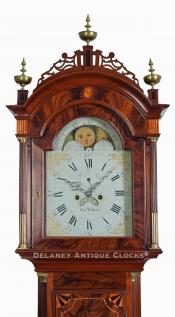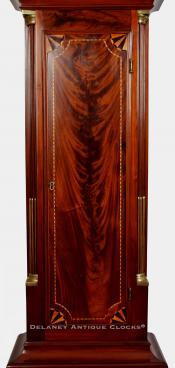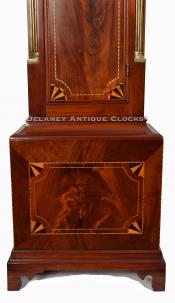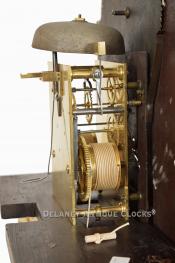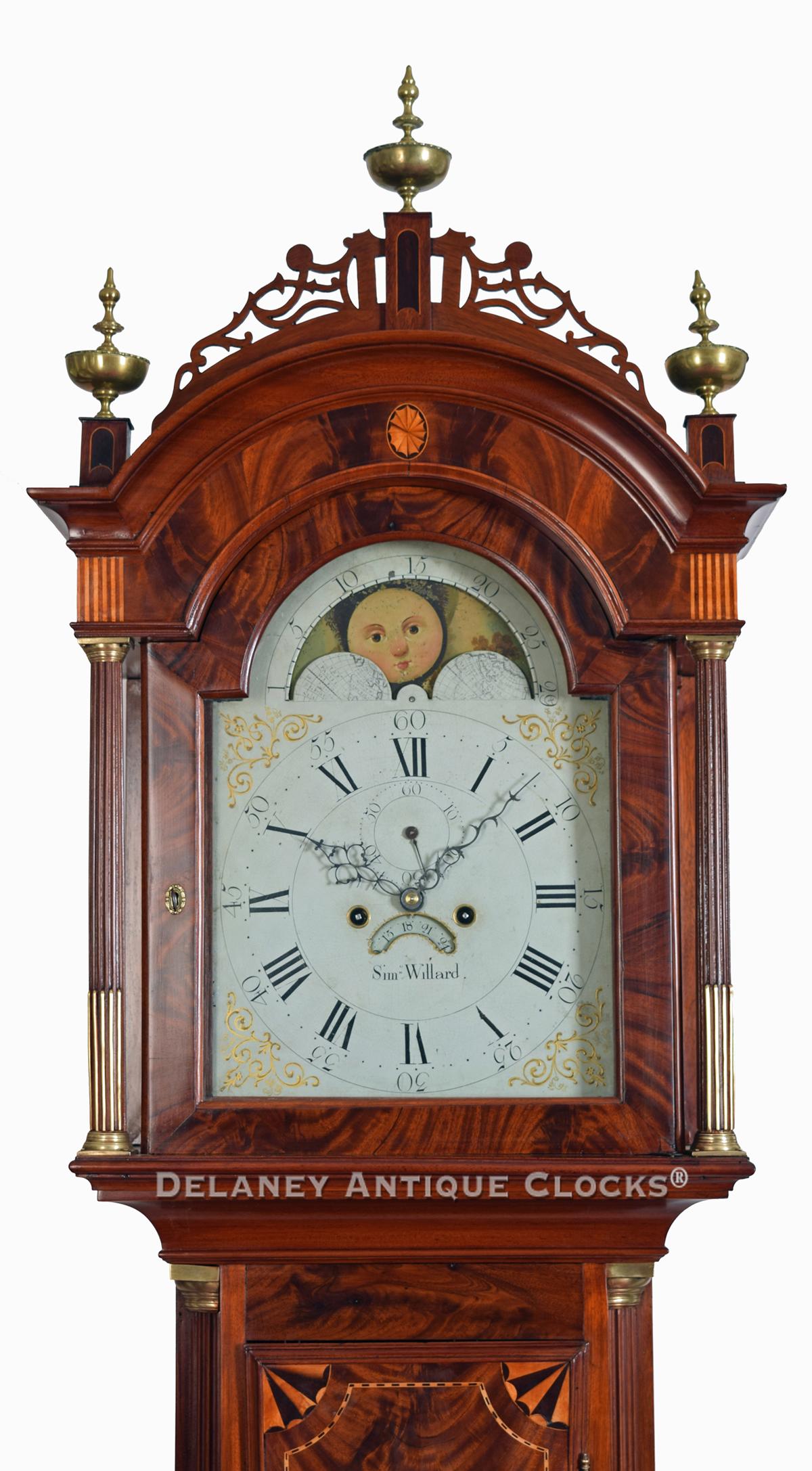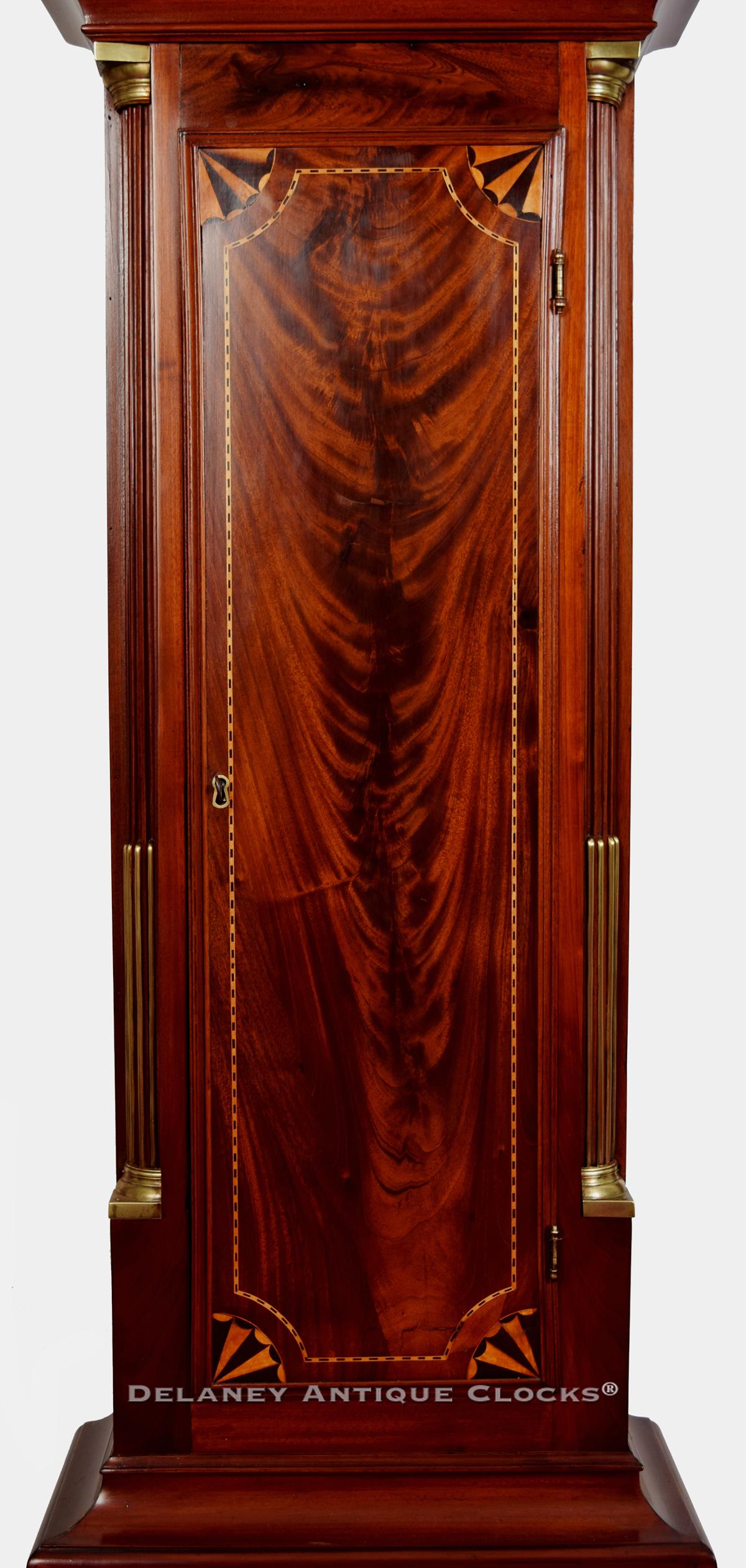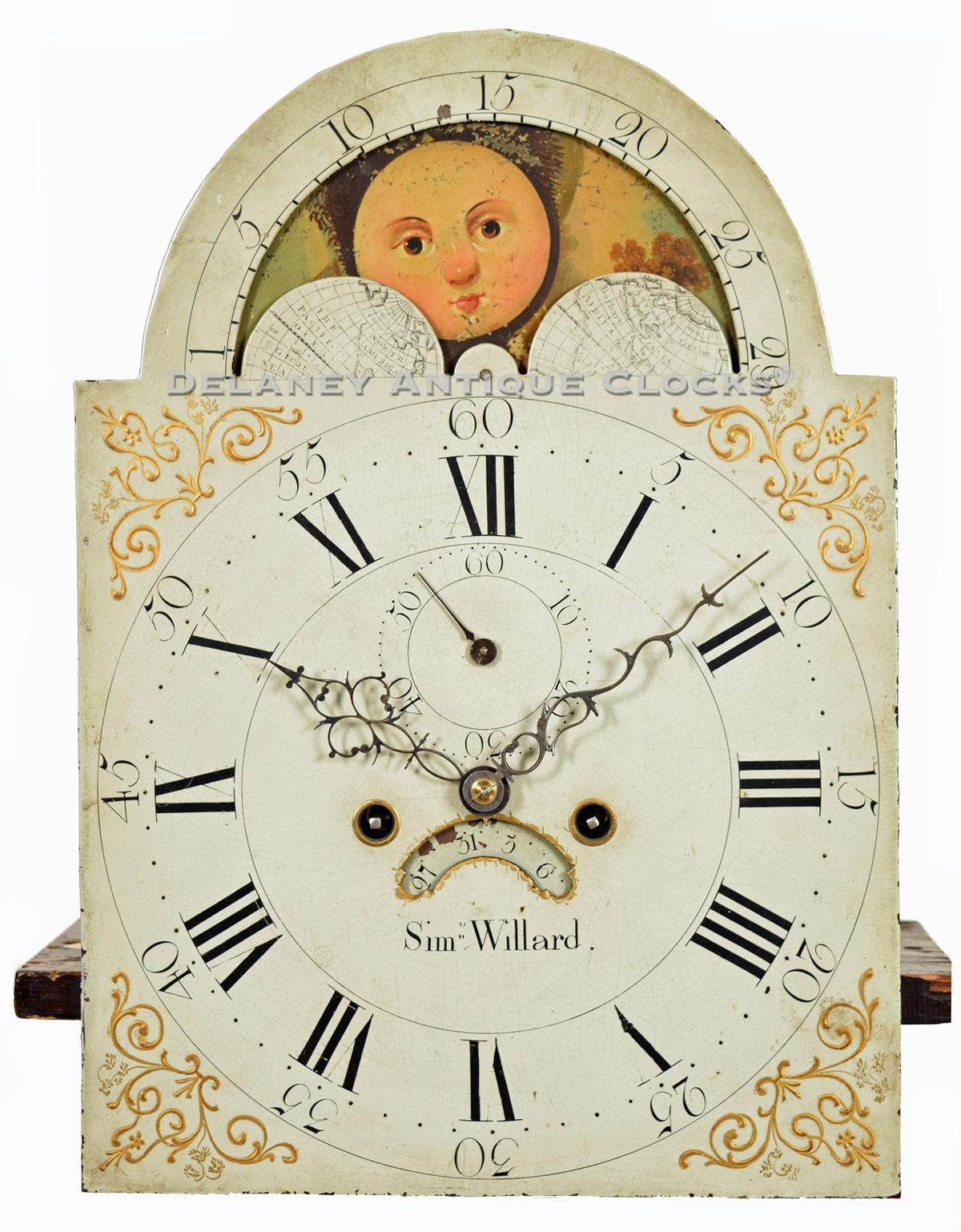Simon Willard Clockmaker, working in Roxbury, Massachusetts. A figured mahogany tall case clock with alternating light and dark veneers and light and dark quarter-fan and half-chevron inlay embellishing the case constructed by Stephen Badlam. XX-35.
Simon Willard of Roxbury, Massachusetts, made this exceptional inlaid mahogany-cased tall case clock. This handsome example epitomizes the best formal case style available during the late 18th century. The complexity of the case design suggests that this clock was specially ordered from Stephen Badlam's cabinet shop. It is currently thought that these Badlam-made cased clocks sold for a considerable premium, more than $100, when the standard Roxbury examples sold for $65. This small, industrious borough of Boston, specifically the boroughs of Roxbury, Charlestown, and Dorchester, became well known for providing clock cases with high-quality construction, pleasing proportions, brass stop fluting, choice figured mahogany and complex inlays.
This cabinet is one of the more ambitious examples offered by the collective group of Boston area clockmakers. The modern shellac-based finish highlights the rich figuring exhibited in the mahogany wood veneers selected for its construction. The finish also highlights the inlaid details. The case is elevated on applied bracket feet. They are well-formed and feature a bold c-scroll return. A double-stepped molding makes the transition to the base. The complex base panel features an intricate inlay presentation, incorporating design elements that include barber pole line inlay, multiple layers of cross-banding, inlaid quarter fans, and figured veneers. Much of this design is repeated in the formatting of the waist door. A rectangular-shaped waist door displays a long, vertically positioned crotch veneer pattern. The corners are decorated with large inlaid quarter fans. An applied molding frames the perimeter. One can access the two red-painted drive weights and brass-faced pendulum bob through this door. The sides of this case are fitted with brass stop-fluted quarter columns that terminate in brass quarter capitals. The bonnet features a double-break arch design. A smooth tympanum separates these moldings. The quality of the wood selected for this location is fantastic. The tympanum is also decorated with inlays. In the center is a full inlaid paterae. Bookend inlays are located on both sides. The top of the upper arch supports a pierced and open fretwork pattern that includes three line-laid and veneered finial plinths. Heavy cast urn-and-spiked brass finials are fitted on each plinth. The bonnet columns are also brass stop-fluted and terminate in brass capitals. The arched bonnet door is veneered. This door opens to access the colorfully painted iron dial.
This imported English Osbourne dial is equipped with a false plate. The time track features Arabic five-minute markers and Roman-style hour numerals. A dotted minute ring separates them. A subsidiary seconds dial and month calendar are located inside the time ring. The four spandrel areas are colorfully decorated with lacy gilt patterns. A moon phase mechanism or lunar calendar is located in the lunette. The lunar calendar or moon phase mechanism is a mechanical almanac. This feature added to the cost due to the extra work involved in producing it. This display would have been valuable to several occupations during the colonial era. Farmers were known to track the moon phase to anticipate the days that offered the most available moonlight. A bright night would be more beneficial to them in scheduling the tilling and harvesting of their fields. Sailors and merchants track the lunar phases to know when the high tide would allow their ships to sail easily to and from their harbor or when the fishing might be best. Numerous religious groups had an almost superstitious litany of rituals best performed by lunar events. The lunar month represents an inconvenient interval of 29 days, 12 hours, 44 minutes, and 2.8 seconds. A tall clock's lunar calendar is set constant at 29.5 days, representing a complete cycle. As a result, a 9-hour setback is required to keep the lunar display current at the end of a single year. The lunar disk features two moons that oppose each other so one can rise while the other is setting. In between these are painted scenes. The first is a pastoral scene featuring two people below a large building. The second scene depicts a British ship burning down to water level. The areas that frame this lunar display are traditionally formatted with depictions of the hemispheres.
This fine movement is constructed in brass and is of good quality. Four-turned pillars support the two brass rectangular-shaped plates. Hardened steel shafts support the polished steel pinions, brass gearing, and a recoil escapement. The winding drums are grooved. The weight-driven movement is designed to run for eight days on a full wind. It is a two-train or a time-and-strike design with a rack and snail striking system. As a result, it will strike each hour on the hour on a cast iron bell mounted above the movement.
This inlaid mahogany case exhibits excellent proportions. It stands approximately 8 feet tall (96 inches) to the top of the center finial. The hood is 22.25 inches wide and 10.75 inches deep.
This beautiful clock was made circa 1792.
Inventory number XX-35.
Simon Willard was born in Grafton, Massachusetts, on April 3, 1753. He was the seventh of twelve children born to Benjamin Willard (1716-1775) and Sarah (Brooks) Willard (1717-1775) of Grafton. While living in Grafton, Simon answered the Lexington alarm on April 19, 1775, along with his brothers. It is thought that by 1782 he moved from Grafton and took up residence in Roxbury as a Clockmaker. Simon became a Master Clockmaker as well as an inventor. He is well known for receiving patents for his roasting jack in 1782, his "Improved Timepiece" or Banjo clock in 1802, and an alarm clock patent. In addition, he trained many men to make clocks who became well-known Clockmakers once their apprenticeships were served. Some of them include the brothers Levi and Able Hutchins, Elnathan Taber, William Cummens, Ezekiel Jones and Daniel Munroe. Some of the more notable public clocks Simon built include the clock in the United States Capitol building's Statuary Hall. He also built a clock for the House of Representatives and the U. S. Senate. Simon died on August 30, 1848, at the age of 95.



